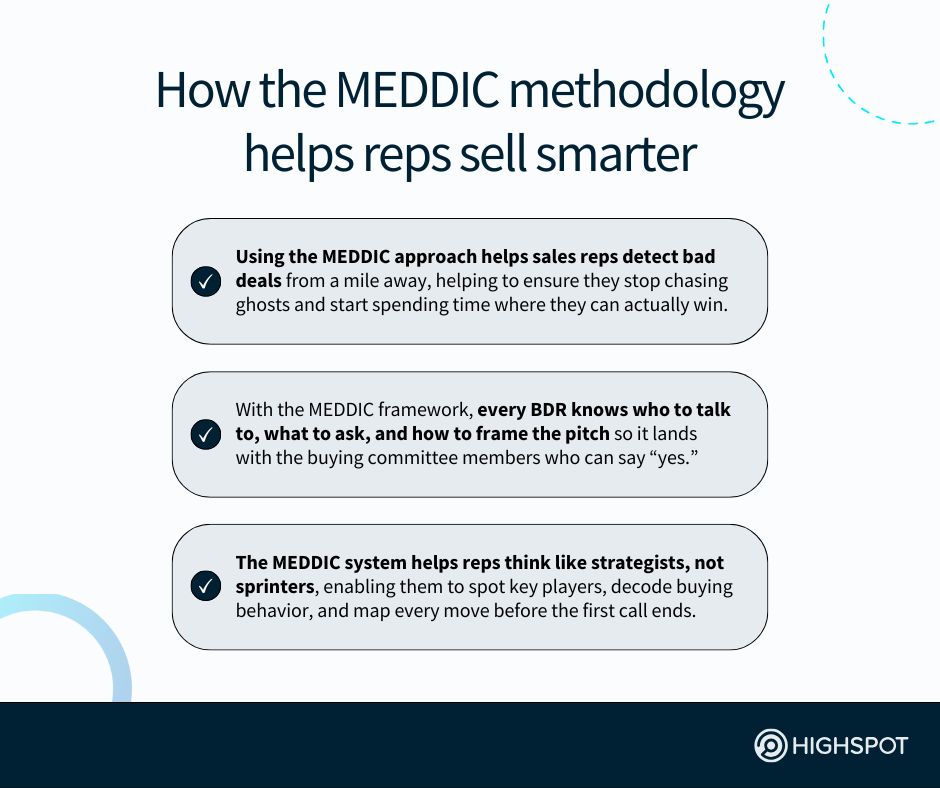Key Takeaways
- The MEDDIC sales methodology helps sales qualify prospects smarter. By focusing on key decision-makers and pain points, reps can use the approach to zero in on high-quality leads and spend less time chasing poor fits.
- The MEDDIC framework thrives in complex deals. It aligns sellers with the buyer’s decision process, enabling reps to tailor solutions to real needs and create champions who advocate internally for your products and services.
- While powerful, the MEDDIC approach isn’t one-size-fits-all. It can be rigid and time-intensive, making it less ideal for fast-paced sales. With training and leadership buy-in, though, it can fuel stronger, predictable wins.
The MEDDIC sales methodology isn’t new, but it still helps B2B sales teams at companies across industries engage target accounts and progress deals in a systematic manner. More to the point, it helps sales reps cut through the chaos, focus on qualified prospects, and win more deals with less wasted motion.
Deciding if the MEDDIC framework is right for you can be tough to know, especially given the plethora of other popular sales methodologies out there today.
“The abundance of options can make choosing just one feel like an impossible task, especially because not just any will do,” Highspot’s Sales Methodology Guide explains.
“Some were built with specific sales cycles or processes in mind, while others aim to account for differences in product types and buyer experiences.”
Unlike other sales methodologies that overcomplicate the obvious, though, the MEDDIC sales process brings go-to-market teams back to what matters: connecting with buyers where they are, eliminating blockers, and streamlining the business decision-making process for key stakeholders involved in deal discussions.
Put plainly, the MEDDIC sales methodology equips your entire team to speak prospects’ language, uncover pain points that matter, and rally buying committee around a shared vision. When you equip, train, guide, and coach your reps on how to apply the approach, they can ‘direct traffic’ from discovery to close.
As long as you have a unified sales enablement platform in your existing tech stack (ideally, one with AI-powered capabilities to streamline teams’ work) that connects with all other critical GTM tools , your BDRs and account executives can execute the proven system and tackle complex sales cycles with confidence.
Want to know if MEDDIC, SPIN, or Challenger is the best sales methodology for your business? Our experts explain how to choose the right one for your organisation, based on your team and goals.
What is the MEDDIC sales methodology?
Meddic stands for Metrics, Economic Buyer, Decision Criteria, Decision Process, Identify Pain, and Champion. It’s a framework for qualifying and pursuing B2B sales leads that are more likely to convert.
It streamlines the sales process by guiding you on what questions to ask to find prospects who need your product. Not only does it help you close deals faster, but it also improves your sales forecast and maximises your revenue potential. It works well in longer, complex sales cycles with multiple stakeholders.
John McMahon created the MEDDIC sales methodology in 1996 to improve lead qualification and sales processes at Parametric Technology Corporation (PTC).
Dick Dunkel and Jack Napoli, John’s colleagues who co-created the MEDDIC sales framework with him, then documented and shared the system throughout the entire company, integrating it into their sales onboarding and training programmes and creating a new, common language for their revenue teams to use.
This structured approach to sales qualification ultimately helped PTC boost its sales from $300 million to $1 billion and revolutionise the B2B sales landscape.

MEDDIC vs. MEDDICC vs. MEDDPICC
The MEDDPICC and MEDDICC methodologies are variations of the original MEDDIC qualification framework. While they share core principles, each version has slight differences to address specific needs within the sales process.
For instance, MEDDPICC is considered the more modern and evolved version.
It builds on the original principles by adding the paper process to help sales teams understand and navigate the customer’s procurement, legal processes, and competition to better understand and position solutions against competitors.
- The added paper process gives sales reps a clear view of what it takes to get a deal over the finish line: from the legal review process to procurement.
- Meanwhile, the competition step ensures sales professionals don’t just sell in a vacuum but rather actively navigate around rivals, differentiating with intent.
Determining if one of these alternative approaches to the MEDDIC methodology is best for you depends on factors like your business model and revenue targets.
MEDDIC vs. other sales methodologies
“How does the MEDDIC sales methodology differ from other sales qualification methodologies?” That question is a common one among GTM leaders today. With that in mind, here’s a bare-bones breakdown of what sets MEDDIC apart.
| Other popular sales methodologies | What differentiates each from the MEDDIC sales strategy framework |
|---|---|
| SPIN selling | SPIN focuses on questioning tactics in sales conversations, while MEDDIC emphasises qualification criteria to help reps assess deal viability across the entire buying process. |
| Challenger sales | Challenger trains reps to teach, tailor, and take control of deals, whereas MEDDIC equips reps to qualify rigorously, understand buyer processes, and identify internal champions to steadily guide deals to close. |
| BANT sales | The BANT model is light on nuance and best for simple sales. The MEDDIC methodology is built for complex sales cycles, uncovering deep buyer pain and mapping stakeholders, processes, and metrics that drive decisions. |
| Solution selling | Solution selling hinges on diagnosing problems to recommend solutions. The MEDDIC sales framework takes that a step further by operationalising lead qualification, so your sales team aligns on what, when, and how to pursue a deal. |
| Sandler sales | The Sandler sales approach trains behaviour and communication skills over time. Meanwhile, MEDDIC zeroes in on deal-by-deal qualification, helping teams pursue what’s winnable and avoid wasting time on unqualified leads that are unlikely to convert. |
How the MEDDIC sales process works with business decision-makers
The MEDDIC sales qualification framework contains six elements to ensure no stone is left unturned when qualifying buyers. Each includes questions that help you determine whether the prospect is a good match for your solution.
If they are, great. Keep selling.
If not, it’s likely time to move on to a more qualified lead.
Metrics
This component of MEDDIC measures the customer’s economic benefit. Simply, it’s the value your solution provides. For example, if a potential customer is intrigued by the support you offer because their current provider is unsatisfactory, create metrics that demonstrate your superior response and resolution times.
This is an excellent opportunity to use case studies about customers with similar pain points or expectations to prove value.
- Discovery question example: “I’m curious, what does success look like for you and your team? Are there any specific KPIs or metrics you hope to improve with our solution?”
Economic buyer
The economic buyer has the ultimate decision-making power and control over the budget. This person is usually higher up the company, such as a senior executive. In some cases, the economic buyer may be a group of decision-makers.
Identify the economic buyer early on. If possible, talk to them about their personal goals, priorities, and what they look for in a vendor when trying to solve specific challenges. Otherwise, try to gather these details from your existing contact.
Use what you learn to create an effective sales pitch that appeals to the economic buyer, even if they won’t be directly using your product or service.
- Discovery question example: “Who is your organisation’s go-to person for this business area? Do they need to see the product before giving the green light? Do they sign off on the project?”
Decision criteria
Buying decision criteria are the standards and specifications the customer will use to evaluate your solution. Knowing these criteria helps you tailor your proposal to meet their exact needs.
The criteria can vary from one company to another, but the most common factors to consider are:
- Features: Buyers want to know if your solution offers the must-have capabilities.
- Compatibility with existing systems: If your product or service doesn’t fit within what a prospect already uses, it’s a hard no from them before the demo even ends.
- Product integrations: Seamless integration with their platforms in their current tech stack can make or break a deal, especially in multi-tool environments.
- Onboarding assistance: Most leads want assurance your team can help them hit the ground running with your offerings, not six months into the contract.
- Pricing: Budget alignment matters for B2B buying committees, but they also want clarity on exactly what’s included, what’s not, and what value they’ll see.
- Return on investment: If you can’t capably show how your solution drives tangible, measurable outcomes (and quickly), you’ll never get past the CFO’s inbox.
If the prospective customer does not have decision criteria, you can influence the criteria to align with your company and product strengths.
- Discovery question example: “What is the most important factor you use to evaluate and decide on the best solution? Do you have a specific budget? How do you plan to measure the ROI if you invest in our product or service?”
Decision process
The decision process outlines the steps and stakeholders involved in the customer’s decision-making journey. Find out the who, when, and how of evaluation, selection, and purchasing of the product.
Understanding this process allows you to align your sales efforts with their timeline and requirements. Furthermore, it will help you avoid losing a sale due to delays. You’ll have a clear picture of what needs to happen from your customer’s side to seal the deal, so you can focus on fulfilling those steps.
- Discovery question example: “What was the process the last time you purchased [similar product]? Can you walk me through your team’s steps to decide on this purchase?”
Identify pain
Identifying the pain involves pinpointing the critical issues your customer faces. This usually involves technical or business problems that are hurting the company. This is an opportunity to use open-ended questions to dig into the pain’s root cause. During the conversation, you might discover hidden needs that could create another opportunity for your product or service.
- Discovery question example: “What are the main problems or bottlenecks you are experiencing? How is this affecting the business?”
The key here is to be specific.
While it’s helpful to know your customer is struggling with poor productivity, it is too vague. But if your customer’s business is facing a 40% decrease in productivity due to outdated collaboration tools, you can align how your product or service can solve this pain point and avoid making false promises.
Champion
The champion is your internal advocate within the customer’s organisation who will support and promote your solution. This person is well-respected in the organisation and benefits in some way from your and their success. They will help you navigate internal politics and gain buy-in from other stakeholders.
- Discovery question example: “Is there someone within your organisation who has influence, speaks positively about our solution, and can help us advocate for it internally? Is there anything we are missing as we prepare a business case?”
Based on your initial call with a prospect, be prepared to determine the ideal number and type of questions. Asking too many can feel like an interrogation.
Asking too few might leave you without enough info to present a proper solution to the right people and close a deal. Gauge the potential customer’s engagement, reception, and responses to find the right balance during the conversation.
The Highspot team discusses how GTM leaders can ensure their reps are ready to use their sales methodology in day-to-day discussions with buyers and, in turn, close deals more efficiently.
MEDDIC sales in action: An example
Imagine you’re pursuing a manufacturing company interested in your ERP software solution. Here’s how you might apply the MEDDIC sales process:
- Metrics: You learn the company wants to boost production efficiency by 20%. Your software’s resource management and automation capabilities can help achieve this.
- Economic buyer: You identify the CRO as the budget-holder and primary decision-maker who will approve the purchase. You work with enablement to build a digital sales room that features materials that this persona cares most about.
- Decision criteria: You find out through chats with the CRO that the company prioritises ease of integration with existing systems and robust customer support.
- Decision process: You discover that the decision process involves an RFP, an initial demo, a proof of concept phase, and a final review by the buying committee.
- Identify pain: You learn the company is struggling with outdated software in its tech ecosystem, leading to frequent downtime and communication bottlenecks.
- Champion: You find an IT manager who is enthusiastic about your solution, has excellent internal relationships, will improve their job with the offering in question, and is willing to advocate for it internally with other buying committee members.
The process will look different for BDRs at a software company versus a medical device provider versus a financial services firm. The point, though, is the MEDDIC approach works well for sales organisations across different industries.

How to implement the MEDDIC sales methodology for your team
Implementing the MEDDIC framework is easier than you might think. It fits right into your existing sales process during the qualification phase. The best way to integrate each part of MEDDIC into your current sales efforts is to:
- Understand your buyers: Work with your marketing team to define buyer personas so that you understand your ideal customer’s roles, challenges, and goals before you talk with them. This will help you identify and engage with the right buyers.
- Define qualification process: Identify gaps and areas for improvement in your current sales qualification process. Then, explore how you can integrate the MEDDIC framework. You can create a flowchart that outlines which resources to use at each step, or conversation guides for sales reps.
- Require MEDDIC documentation: Create a standard MEDDIC template or fields within your CRM to document all customer interactions. As MEDDICC CEO Andy White said, ”Existing processes need to shift to embrace MEDDICC; for example, QBR formats should be adapted to include MEDDICC language.”
- Equip sales reps with MEDDIC sales training: Train and coach your sales professionals and sales leaders on the MEDDIC framework. Utilise sales enablement tools to provide real-time support and guidance. Supply them with training materials, customer engagement resources, playbooks, battle cards, sales pitch templates, messaging, and objection-handling strategies.
- Gain leadership buy-in: Secure major stakeholder support early on. Without this advocacy to promote MEDDIC adoption, you’ll face an uphill battle trying to integrate its usage into sales culture. “Sellers and sales managers are spinning so many plates that adding a new qualification framework plate to their workload without top-to-bottom support stands the chance of being de-prioritised, and subsequently fading away as just another failed initiative,” said Whyte.
Improved lead qualification accuracy. Shorter, more predictable sales cycles. Stronger sales and marketing alignment. Better stakeholder engagement. Higher win rates on deals. That’s what you can realise with MEDDIC firmly in place.
Why ongoing MEDDIC sales training is essential to your GTM success
A clean, quick implementation is optimal. But don’t forget that continuous sales coaching and training is the other side of the sales methodology coin. There are a few key best practices to follow to ensure your sales professionals are able to employ the MEDDIC approach effortlessly in their day-to-day lead engagement.
Sales leaders need ongoing MEDDIC training to drive consistency across every rep
In a complex sales environment, reps only approach qualification the same way when you train for it. Go-to-market leaders who revisit MEDDIC regularly can help their sales representatives speak the same language and follow the same exact process with every single opportunity they take on.
When every seller uses the same decision process map, it gets easier to spot gaps, coach smarter, and align sales enablement efforts to what actually works.
For instance, one rep might breeze past the economic buyer while another gets stuck navigating the approval process, costing you deals and credibility. Ongoing sales training closes those gaps and turns good reps into consistent top performers.
Understanding prospects’ pain points requires more than a one-time MEDDIC certification
You can’t truly identify pain, if you only practise it once. The best reps treat pain discovery as a skill that sharpens with use. Providing quarterly MEDDIC training can help your sales team ask better questions, listen for emotional cues, and connect problems to impact so that every conversation advances deal discussions.
When sellers revisit MEDDIC skills regularly to ensure they’re following the framework, they’re more likely to qualify leads accurately, move them further down the sales funnel, and gain the trust of multiple stakeholders involved in deals.
Continual MEDDIC training helps reps adapt as buyers’ decision-making processes shift
Your buyer’s world is always changing. So, your reps should be too.
Continual MEDDIC training gives sellers the tools to adjust in real time, update their decision process map to account for lead activity, and stay synced with how buyers make a final decision regarding whether or not to move forward.
That agility isn’t optional when purchasing decisions involve several stakeholders with competing agendas. Regular practice—ideally using AI sales role play tools—ensures your BDRs can navigate shifts with confidence.




